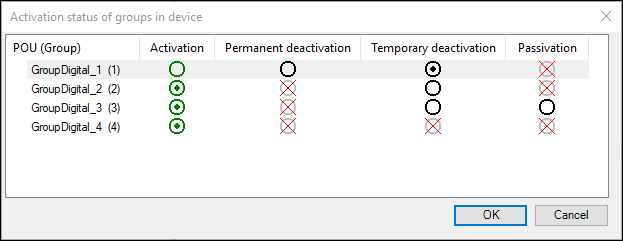Command: Deactivate / activate group
Call: Context menu of the SafetyApp object
Requirement: To execute the command, you need to be logged in with the standard application. The standard application must be in the [run] state.

Safety POU | Name of the POU in the device tree |
Activation | A deactivated group is permanently activated. After activating the group, the associated POU is stopped. To start it, its RUN signal must be set next from 0 to 1. |
Permanent deactivation | The group is permanently deactivated. The substitute values for the outputs of the corresponding POU are set. |
Temporary deactivation | The group is deactivated one time until the next time the EtherCAT SafetyModule is switched on and is then automatically reactivated. During deactivation, the substitute values for the outputs of the POU are set. |
Passivation | Passivation: A group with exactly one FSoE Module is deactivated when the connected device has been disconnected from the installation. After deactivation by online command, the connection defined in the group must report a |
Timeout Passivation | Timeout |
OK | After confirming the dialog, a login dialog opens. The user need to have the necessary permissions to execute this command. |
| Current deactivation status of the group in the safety module |
| Selectable as new deactivation status |
| Selected new deactivation status. Becomes active after confirmation with OK and successfully logging in. |
| Deactivation method not enabled for this group. (Activation is always possible.) |
The status changes from active to inactive immediately after the command is executed. The status changes from inactive to active only after a positive edge of the signal for RUN/STOP. The status of the POU (active / inactive) is displayed in the device tree behind the object name.



